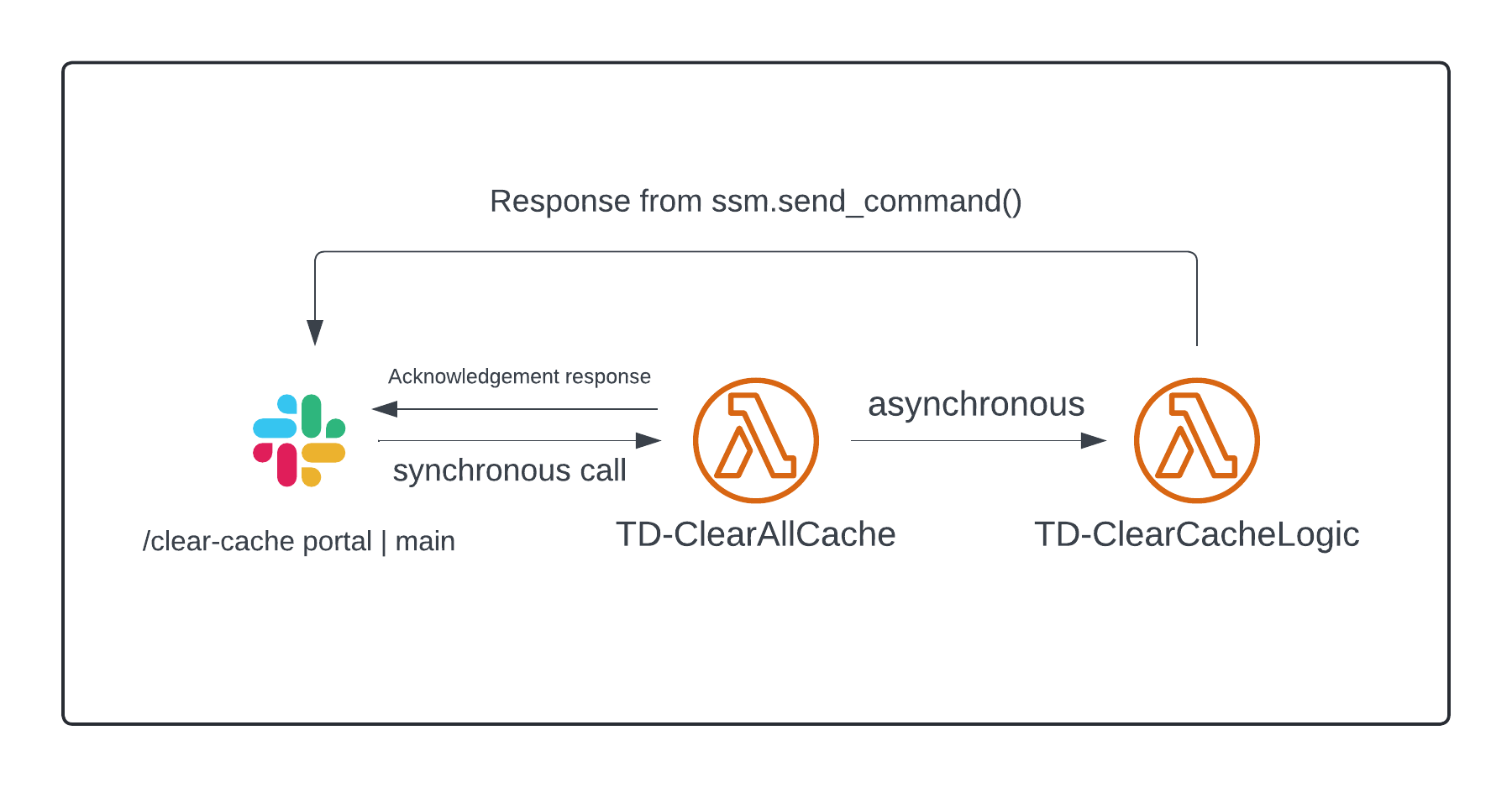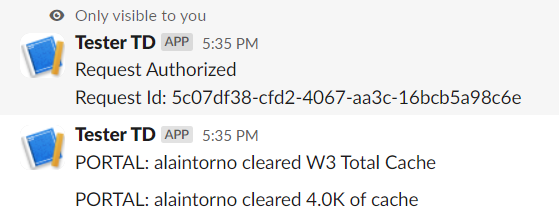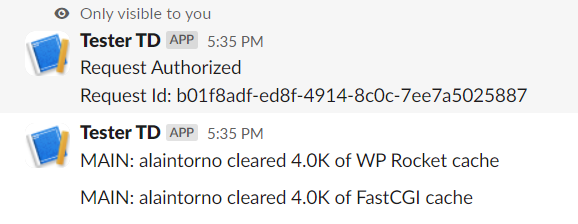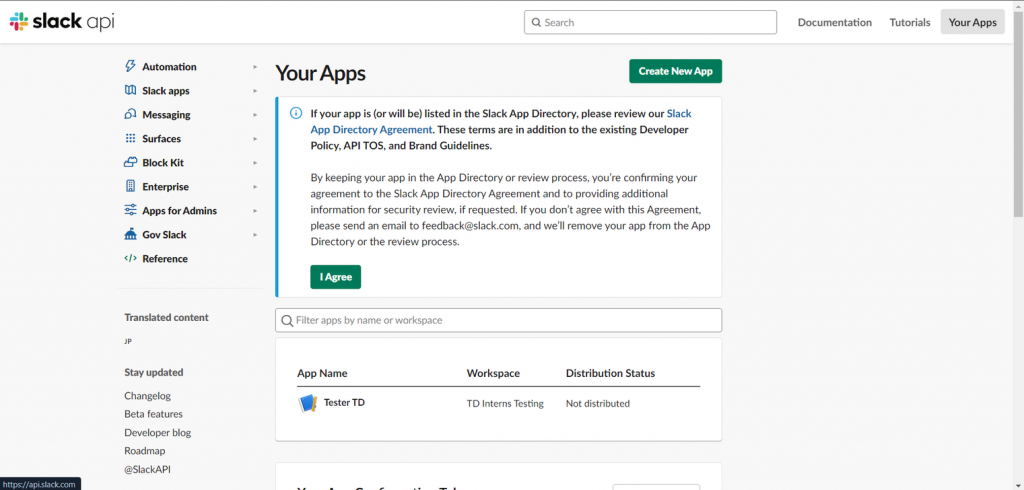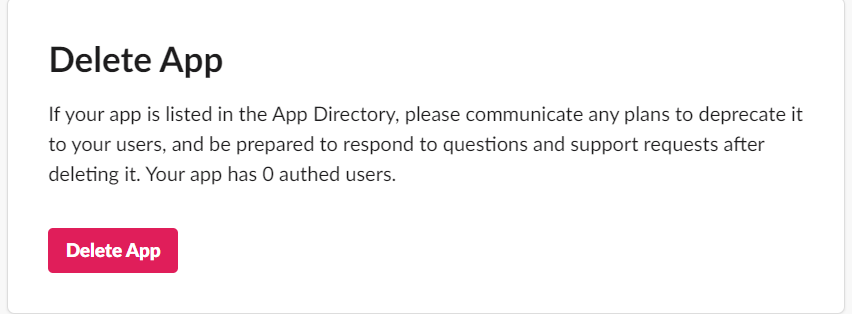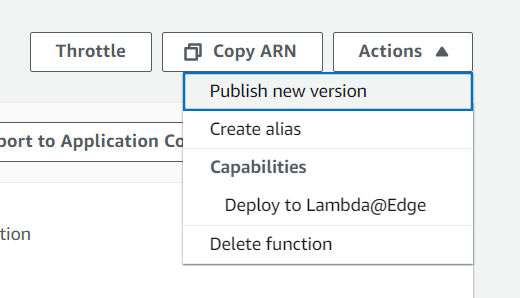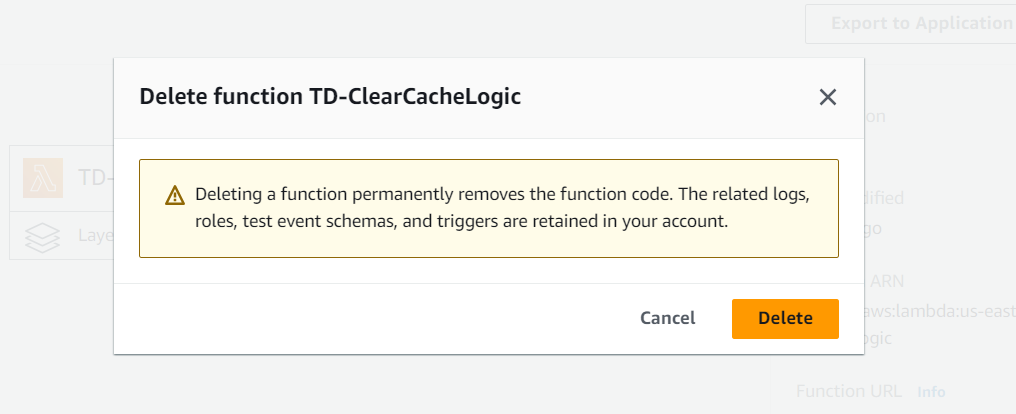Cached data can sometimes be corrupted, which can lead to performance problems. It can also prevent applications and websites from loading the latest version of their content. That’s why clearing cache is a must, not only does it resolve these issues, it also clears up space. Clearing cache is also a way to protect privacy since cache can hold sensitive information. Currently, when purging the cache for both TD Portal and TD Main Site, 4 slack commands have to be used: For TD Portal: For TD Main Site: Using these individual commands can be quite a hassle and can also be time-consuming. To resolve this problem, a new slack command has been created (/clear-cache) that takes in a parameter, which can be either portal (For TD Portal) or main (For TD Main Site). Architecture Diagram If you already have a Slack Application, you may skip this step. Before we create the Lambda functions, we must first create the SSM Documents that will be accessed by the Lambda functions. We will be creating 3 documents: TD-PurgeW3, TD-PurgeFastCGI, and TD-PurgeWPRocket. We will be creating 2 Lambda functions. The first one (TD-ClearAllCache) accepts a synchronous call from Slack and then returns an acknowledgment response to Slack. The second one (TD-ClearCacheLogic) accepts an asynchronous call from the first lambda function and then sends a response to Slack through the use of the Scroll down, then click Delete App
About the task
Implementation steps
Creating Slack Bot
Your own app nameThe Slack Workspace where you will put the bot inCreating the SSM Documents
{
"schemaVersion": "2.2",
"description": "Purges NGINX FastCGI cache",
"parameters": {
"slackHook": {
"type": "String",
"description": "(Required) Slack Web hook."
},
"requesterName": {
"type": "String",
"description": "(Required) Slack user who purges the cache."
},
"targetInstance": {
"type": "String",
"description": "(Required) Portal or Main site"
}
},
"mainSteps": [
{
"action": "aws:runShellScript",
"name": "runShellScript",
"inputs": {
"runCommand": [
"#!/bin/bash",
"hook='{{ slackHook }}'",
"sudo -u ubuntu -i -- wp w3-total-cache flush all --path=[Put here working directory]",
"#Notify Slack Channel",
"curl -H \"Content-type: application/json\" -d '{\"text\": \"{{ targetInstance }}: {{ requesterName }} cleared W3 Total Cache\"}' -X POST $hook"
]
}
}
]
}
{
"schemaVersion": "2.2",
"description": "Purges NGINX FastCGI cache",
"parameters": {
"slackHook": {
"type": "String",
"description": "(Required) Slack Web hook."
},
"requesterName": {
"type": "String",
"description": "(Required) Slack user who purges the cache."
},
"targetInstance": {
"type": "String",
"description": "(Required) Portal or Main site"
}
},
"mainSteps": [
{
"action": "aws:runShellScript",
"name": "runShellScript",
"inputs": {
"runCommand": [
"#!/bin/bash",
"hook='{{ slackHook }}'",
"Working_Directory=\[Put here working directory]",
"if [[ -d \"$Working_Directory\" ]]; then",
"dir_size=$(sudo du -sh $Working_Directory | awk '{print $1}')",
"echo \"Removing cache...\"",
"sudo rm -rf $Working_Directory/*",
"#Notify Slack Channel",
"curl -H \"Content-type: application/json\" -d '{\"text\": \"{{ targetInstance }}: {{ requesterName }} cleared '$dir_size' of cache\"}' -X POST $hook",
"else",
"echo \"Cache is empty\"",
"fi"
]
}
}
]
}
{
"schemaVersion": "2.2",
"description": "Purges WP Rocket cache",
"parameters": {
"slackHook": {
"type": "String",
"description": "(Required) Slack Web hook."
},
"requesterName": {
"type": "String",
"description": "(Required) Slack user who purges the cache."
},
"targetInstance": {
"type": "String",
"description": "(Required) Portal or Main site"
}
},
"mainSteps": [
{
"action": "aws:runShellScript",
"name": "runShellScript",
"inputs": {
"runCommand": [
"#!/bin/bash",
"hook='{{ slackHook }}'",
"Working_Directory=\[Put here working directory]",
"if [[ -d \"$Working_Directory\" ]]; then",
"dir_size=$(sudo du -sh $Working_Directory | awk '{print $1}')",
"echo \"Removing cache...\"",
"sudo rm -rf $Working_Directory/*",
"#Notify Slack Channel",
"curl -H \"Content-type: application/json\" -d '{\"text\": \"{{ targetInstance }}: {{ requesterName }} cleared '$dir_size' of WP Rocket cache\"}' -X POST $hook",
"else",
"echo \"Cache is empty\"",
"fi"
]
}
}
]
}
Setting up Lambda Functions
ssm.send_command().
You can get this from your Slack ApplicationWebhook URL from SlackSlack channel where you will test/use the command
Instance IDInstance IDTD-PurgeFastCGITD-Purge-W3TD-PurgeWPRocket
import json
import boto3
import base64
import os
import hashlib
import hmac
lambda_client = boto3.client('lambda')
#Set up constants
SLACK_CHANNEL = os.environ["SLACK_CHANNEL"]
SIGNING_KEY = os.environ["SIGNING_KEY"]
SLACK_HOOK = os.environ["SLACK_HOOK"]
def lambda_handler(event, context):
#Parse event data
slack_signature = event['headers']["x-slack-signature"]
slack_timestamp = event['headers']['x-slack-request-timestamp']
slack_payload = event['body']
payload = parse_slack_payload(slack_payload)
from_channel = payload["channel_name"]
#Check if request originates from valid source
from_valid_source = verify_source(signing_key=SIGNING_KEY.encode('utf-8'),
timestamp=slack_timestamp,
body=base64.b64decode(slack_payload).decode('utf-8'),
slack_signature=slack_signature,
from_channel=from_channel
)
if from_valid_source:
new_payload = {
'body': {
'target_instance': payload['text'],
'requester': payload["user_name"],
'hook': SLACK_HOOK
}
}
try:
lambda_client.invoke(FunctionName='TD-ClearCacheLogic',
InvocationType='Event',
Payload=json.dumps(new_payload)
)
return f'Request Authorized \nRequest Id: {context.aws_request_id}'
except Exception as e:
return f'{e}'
else:
return "You're not authorized to do this operation"
def parse_slack_payload(data):
# decode the data using the b64decode function
decoded_data_raw = base64.b64decode(data).decode('utf-8').split('&')
decoded_data_formatted={key:value for key, value in [i.split("=") for i in decoded_data_raw]}
return decoded_data_formatted
def verify_source(signing_key, timestamp, body, slack_signature, from_channel):
basetring = f'v0:{timestamp}:{body}'
hmac_digest = hmac.new(key=signing_key,
msg=basetring.encode('utf-8'),
digestmod=hashlib.sha256).hexdigest()
if hmac.compare_digest(slack_signature, f'v0={hmac_digest}') and SLACK_CHANNEL == from_channel:
return True
import boto3
from botocore.config import Config
import os
import time
#Set up constants
PORTAL_INSTANCE_ID = os.environ["PORTAL_INSTANCE_ID"]
MAIN_INSTANCE_ID = os.environ["MAIN_INSTANCE_ID"]
SSM_PURGE_FASTCGI = os.environ["SSM_PURGE_FASTCGI"]
SSM_PURGE_W3 = os.environ["SSM_PURGE_W3"]
SSM_PURGE_WPRocket = os.environ["SSM_PURGE_WPRocket"]
def lambda_handler(event, context):
payload = event["body"]
hook = payload['hook']
requester = payload['requester']
target_instance = payload['target_instance']
purge_cache(hook, requester, target_instance)
return
def purge_cache(hook, requester, target_instance):
target_instances = {
'portal': {
'instance_id': PORTAL_INSTANCE_ID,
'region': [put here the region where your instance is located e.g 'us-east-1']
},
'main': {
'instance_id': MAIN_INSTANCE_ID,
'region': [put here the region where your instance is located e.g 'us-east-1']
}
}
instance_ssm_documents = {
'portal':{
'w3': SSM_PURGE_W3,
'fastcgi': SSM_PURGE_FASTCGI
},
'main': {
'wprocket': SSM_PURGE_WPRocket,
'fastcgi': SSM_PURGE_FASTCGI
}
}
for target_document in instance_ssm_documents[target_instance].values():
target_instance_id = target_instances[target_instance]['instance_id']
target_region = target_instances[target_instance]['region']
print(target_instance_id, target_region, target_document)
ssm = boto3.client('ssm', config=Config(region_name = target_region))
response = ssm.send_command(
InstanceIds=[
target_instance_id,
],
DocumentName=target_document,
Parameters={
'slackHook': [hook],
'requesterName': [requester],
'targetInstance': [ target_instance.upper() ]
},
TimeoutSeconds=30
)
print(response)
time.sleep(6)
Connecting the Slack Slash Command to the Lambda function using the Function URL
/clear-cacheThe Function URL goes herePut here what your slash command is supposed to doHere you can put the parameters that the command needs in order to workUsing the Slash Command
/clear-cache portal | main
[portal | main] are the parameters to choose from. Whether to clear TD Portal or TD Main Site./clear-cache portal:
/clear-cache main:Rollback Plan
Deleting Slack App:
Deleting Lambda Functions:
Unified Slack Automation for Purging the Cache
AWS, Azure, and GCP Certifications are consistently among the top-paying IT certifications in the world, considering that most companies have now shifted to the cloud. Earn over $150,000 per year with an AWS, Azure, or GCP certification!
Follow us on LinkedIn, YouTube, Facebook, or join our Slack study group. More importantly, answer as many practice exams as you can to help increase your chances of passing your certification exams on your first try!
View Our AWS, Azure, and GCP Exam Reviewers Check out our FREE coursesOur Community
~98%
passing rate
Around 95-98% of our students pass the AWS Certification exams after training with our courses.
200k+
students
Over 200k enrollees choose Tutorials Dojo in preparing for their AWS Certification exams.
~4.8
ratings
Our courses are highly rated by our enrollees from all over the world.


